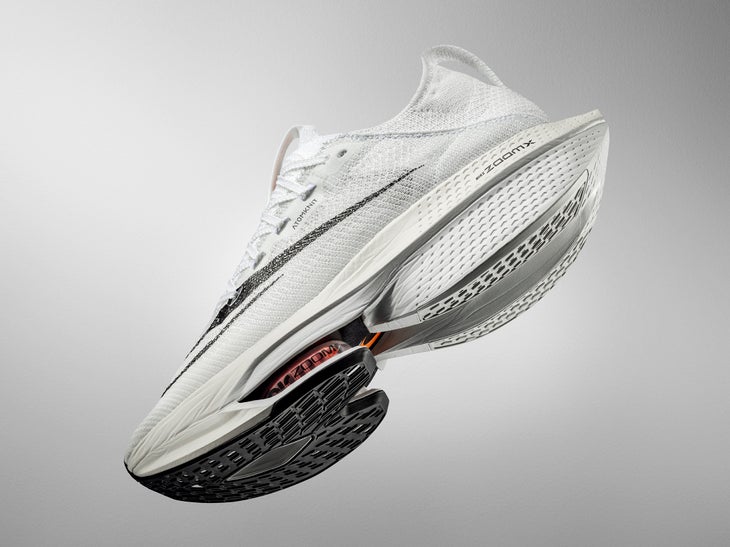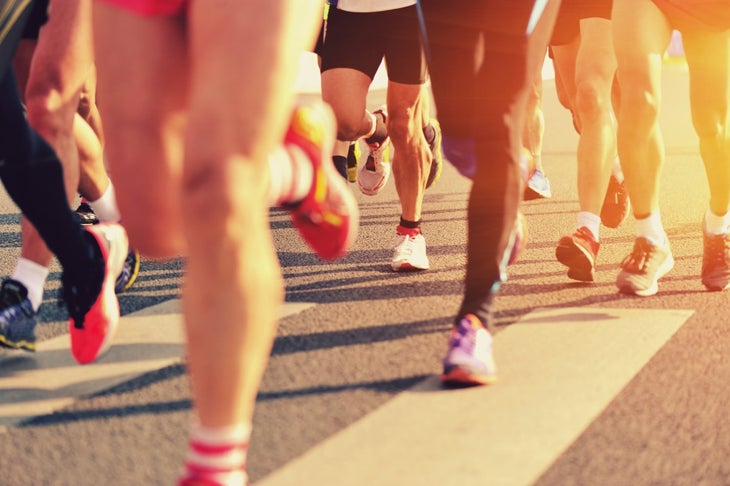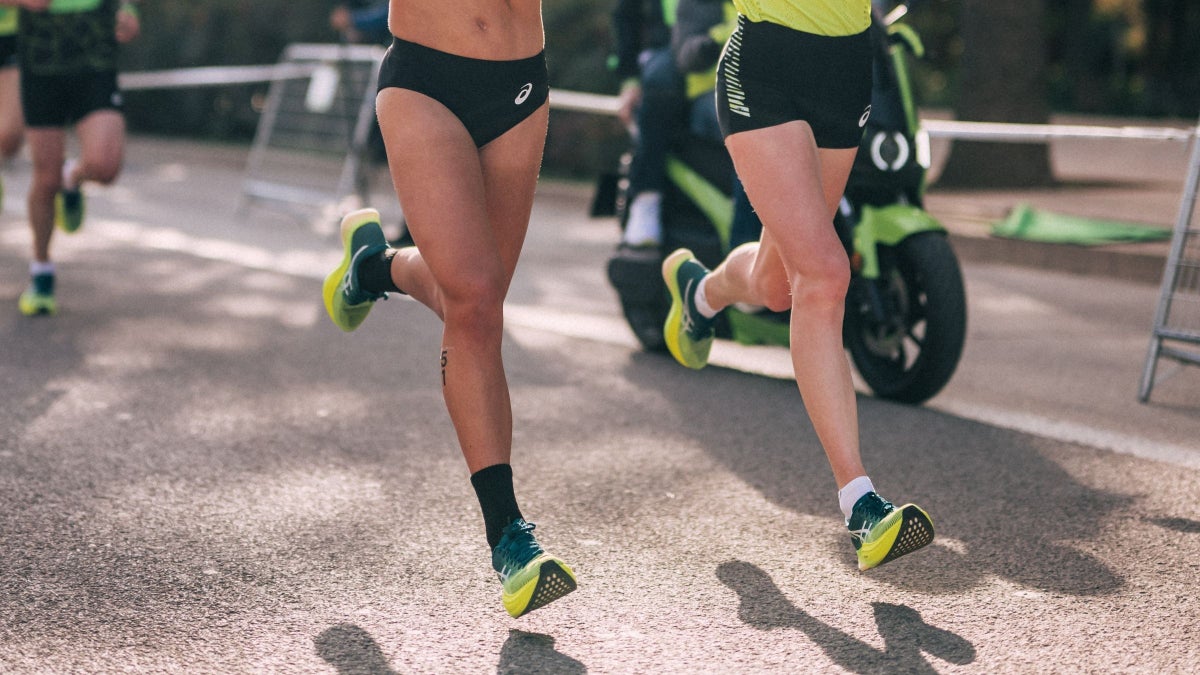No products in the cart.
Outdoor Adventure
Racing Shoes: What You Need to Know
If you want to run fast, you have to dress the part. Yes, that means wearing your favorite clothes that are light, breathable, allow full range of motion, and won’t chafe late in a race. But most importantly it means lacing up a pair of light and fast race-day shoes.
Today’s racing shoes are more effective and more diverse than ever before. Finding the right pair for you depends on the type of race you’re running, your pace, your stride, and your budget. Here are eleven questions to help you sort out what shoes to buy for your race, plus how to optimize how you train and race in them.
1. How important is your race time?
If you’re going after an ambitious goal time you might want to invest in a high-end racing model tooled for top performance. If your goal is just to finish or to enjoy a strong run among friends, you might favor the most comfortable, cushy pair of shoes you can find. There are many options in each category, so it will come down to your goals and expectations, how much you want to invest in running shoes and, most importantly, finding a pair of shoes that works well for your feet and your gait.
2. Are supershoes worth the price?
Let’s be blunt so you avoid sticker shock: high-end racing shoes with carbon-fiber propulsion plates embedded in the midsoles are expensive! If you’re going to buy one of those top-tier models, you should expect to pay $180 to $275.
Are the shoes worth it? If you want to run as fast and efficiently as possible relative to your training, the cost certainly is. Can you run a fast race without those newfangled shoes? Yes, of course, but you’ll have to work slightly harder to do it. Generations of runners ran fast times and set new personal bests wearing shoes that would seem low-tech today. If you don’t want to spend that much money on a pair of shoes, there are many light and fast mid-range shoes that you can consider, and many runners race well in their trainers.
3. What distance are you racing?
For longer races—10K, half marathon, marathon, and ultra-distance events—you’ll probably want to have some cushioning under your feet. That doesn’t mean you have to select a maximally cushioned shoe with a high stack of midsole foam, but it definitely means you don’t want a minimalist shoe unless you do the majority of your training in them. No matter if you’re on the roads or trails, if you’re running long distances most runners appreciate some cushy bounce underfoot in the later miles of the race—and you can now get that without adding weight, due to today’s ultra-light foams. For shorter distances, however, you might want a shoe that’s lower to the ground and has a more agile feeling conducive to faster paces.
4. Are carbon-fiber supershoes for you?

Nike was the first to debut what has become known as “supershoes” in 2016, but since then every brand has developed its own version. What’s special about these newfangled shoes is the combination of a thick, ultra-light, super-responsive midsole foam with an embedded, curved, rigid carbon-fiber plate. These components and construction return more energy to the stride than shoes with traditional midsole materials and no plates.
There’s some debate as to how much any carbon-fiber shoes can benefit a marathoner running at a pace slower than approximately 8:30 per mile, as some models were definitely designed and tested to run at much faster speeds. However, a 2018 New York Times report found that slower runners improved their times about the same as faster runners did when wearing the original Nike Vaporfly 4%.
Carbon-fiber racing shoes are not a shortcut to a faster time, however. Your aerobic fitness, leg strength, and running economy are the biggest factors in helping you run faster in your race, so you can’t skimp on training. No matter what speed you’re running, the carbon-fiber plates help stabilize the ankle joint and reduce the load on the calves. But the rigid rockers of supershoes require you to run the same gait the entire way, and most are tuned to the forward-leaning, quick-cadence, powerful-push-off stride of a strong, efficient runner. If you get fatigued and slow your pace considerably, you won’t get the same benefits from these shoes, and you might experience discomfort or even set yourself up for increased injury risk, as the shoe’s rebound continues to amplify every movement, even inefficient ones.
The components and geometry of each shoe vary slightly, however, and, as a result, every shoe feels and runs a little differently. Each rocker shape and foam rebound is tuned to a different stride pattern and feels somewhat off from all others. You’ll need to try several models out to know which one works best for you and your running style. The good news: more and more models are increasingly suitable for mortal runners.
“One thing that’s been constant with these shoes is a very intense focus of the elite runner, but what has expanded in this category is that the focus is now on the four-hour marathoner the five-hour marathoner, and the more casual runners who are really engaged in it,” says A.J. Andrassy, the global director of performance running footwear for ASICS. “Now they see the benefits an elite racing shoe can provide for their race, and they can recognize the recovery benefits that they can get from training and racing in a shoe like this.” To accommodate more runners, ASICS has developed two versions of its high-end super shoes—the Metaspeed Sky and Metaspeed Edge—for runners with longer, more powerful strides and runners with shorter, quicker strides.
5. What about recovery benefits?
One of the secondary benefits of high-end racing shoes with carbon-fiber plates is that the resiliency of the advanced foams tends to result in less fatigue in your lower legs compared to traditional running shoes. Many runners—both elite and recreational—have reported significantly reduced recovery times required before running without soreness again after a long weekend run, or after an all-out marathon.
“I think the biggest change is the recovery process,” says Emma Bates, a 2:24 marathoner who runs in the ASICS Metaspeed Sky+ and is competing for the U.S. at the 2022 World Championships. “I can definitely recover a lot quicker after long runs and I have been doing faster long runs than ever before. And I think I’m able to do it because of the shoes. When I’ve run a marathon, I feel like a week later I can run again, and I think that’s what’s really cool about it. You definitely don’t feel as beat up and you can come back a lot quicker.”
6. What are some top-end carbon-fiber racing models?
Some of the most popular current models with near-maximal cushioning for longer races are:
- Adidas Adizero Adios Pro 2 ($220)
- Altra Vanish Carbon ($240)
- ASICS Metaspeed Sky ($250)
- ASICS Metaspeed Edge ($250)
- Craft CTM Ultra Carbon Race Rebel ($250)
- Brooks Hyperion Elite 3 ($250)
- New Balance FuelCell RC Elite v2 ($230)
- HOKA Carbon X 3 ($200)
- Nike Vaporfly Next% 2 ($250)
- Nike Air Zoom Alphafly Next% ($275)
- Puma Deviate Nitro Elite ($200)
- Saucony Endorphin Pro 2 ($199)
- Skechers GOrun Speed Freek ($200)
New models and updates come out regularly.
When running at faster paces for shorter distances, some runners prefer a more nimble, lower-to-the-ground feel with less foam than the high-stack long-haul racers listed above. Those slimmer models are not only more agile, they’re also lighter. For a road mile race or a 5K, you might choose:
- ASICS Metaracer ($200)
- HOKA Rocket X ($200)
- New Balance Super Comp Pacer ($150)
- Skechers GORun Speed Elite ($180)
These carbon-plated shoes have less of a bouncy feeling and more of a smooth and fast flow from heel to toe.
7. What are some light and fast mid-range shoes?

If you’re not sure you want to fork over a big chunk of money for a pair of racing shoes, you still have options. There are plenty of lightweight, well-cushioned shoes without carbon-fiber plates that can help you get to the finish line relatively fast and efficiently, with the added benefit that they tend to be more accommodating to a wider variety of strides and paces. Most of them utilize the same advanced, high-rebound foams as their carbon-fiber siblings, which research has demonstrated is the key component in the supershoe magic, not the plates.
A few top models to consider are Saucony Endorphin Speed 2 ($160), which has a flexible plastic plate embedded in a hyper-resilient foam midsole for a lively, bouncy ride. Salomon’s flyweight S-Lab Phantasm ($180) doesn’t have a plate, but it has an extremely energetic midsole. Others with a good blend of responsive foam, rockered ride, and light, fast feel include Adidas Adizero Boston 10 ($140), New Balance FuelCell Rebel v2 ($130), Topo Specter ($150), and Under Armour HOVR Machina 3 ($150). For more traditional, low-to-the-ground racing flats with a minimal layer of energetic foam, flexible forefoot, and a featherweight vibe, consider Saucony’s Fastwitch 9 ($100), ASICS Hyper Speed ($90) Altra’s Escalante Racer ($140) are.
8. What is most important when trying on?
No matter what distance or pace you’re running, the most important factor in selecting your race-day shoes is fit. How a shoe matches both the length and shape of your feet, as well as your specific gait pattern, is of the utmost importance.
Keep in mind that your feet will likely swell during long races (especially in hot weather) and what feels comfortable at the start might feel uncomfortably cramped later in the race. A shoe with some wiggle room for your toes will be good if you’re running longer distances—providing both width for splay and length for flexing and swelling. One rule of thumb is to use your thumb: after lacing up, stand in the shoe and check that it allows a thumb’s width of space between your longest toe and the end of the toebox.
The best way to figure out which shoes might work for you is to visit your local specialty running shop and have one of the store’s shoe-fitters take you through a try-on process with several models. They might first digitally scan your feet to find those that match your foot shape to narrow the field, then let you run in each pair on a treadmill or along the sidewalk. At the very least, compare a variety of models with short bursts of running in the store. As you run in them, pay attention to how each shoe fits your foot, feels while running—at race pace—and performs differently than the other models, looking for the one where everything flows and the shoe disappears on the run.
9. What socks should you wear?
Racing shoes are not the only thing you’ll be wearing on your feet when you line up for a race. The wrong socks can ruin your race day no matter how advanced your shoes are.
What socks should you wear? Thickness and fabric preferences vary, although many runners select thinner models for race day to ensure a secure fit and maximal breathability. Don’t buy a new pair at the pre-race expo and wear them in your race. Choose a pair that you’ve worn on long training runs in similar conditions to what you’ll be racing in. Make sure there is not even the slightest discomfort when you wear them with your new race shoes. The best marks of good race-day socks are that they are so comfortable and so efficient at wicking sweat off your skin you forget you’re wearing them.
10. How much should you run in your racing shoes before your race?
There’s really no such thing as “breaking in” a new pair of shoes anymore. That was necessary when shoes had leather or vinyl elements that might stretch and stiff sole materials that needed to mold to your foot. You should expect your shoes to fit and ride great right out of the box.
But there are good reasons to run in your new racing shoes a little bit in the weeks before your race so you can get used to what they feel like. Your race shoes will feel and perform much differently than the shoes you’ve been training in and might alter your gait while running at your race pace. Consider wearing them for a tempo run in the weeks before your race and/or do post-run strides in them several times a week. Many higher-mileage runners will do at least one long run in their racing shoes pre-marathon to be confident of how they feel in the later miles.
11. How often should you train in your racing shoes?
This has been a popular topic as more brands have unveiled their carbon-fiber racing shoes and people enjoy running in them so much they want to wear them every day. In general, you shouldn’t train a lot of miles in the specific shoes you’ll be racing in for a couple of reasons. First, the midsole foam material won’t be as springy and responsive on race day if you’ve logged a lot of miles in them. If you like the feel of your race-day shoes and want to wear them often, you might consider buying a second pair to wear on occasional training runs.
The second reason not to wear them every day is that shoes with rigid carbon-fiber plates don’t allow for natural dorsiflexion of your foot (upward turning of your toes). Although research is lacking so far, some elite and age-group athletes suggest training too many days a week in carbon-fiber racing shoes can lead to numbness in the forefoot, strained calf muscles, and Achilles tendons, and stress reactions in the plantar tissue under the feet.
In addition to injury risk, Samantha Cocca, an athletic trainer and strength and conditioning coach in Denver, cautions runners not to wear super shoes every day in training because running in such stiff shoes could weaken the muscles under their feet and toes since the shoe is providing much of the propulsion. “It’s great when you’re running in the shoes, but the second that you’re not running in the shoes you’re just creating a stress you’re hiding in these shoes,” Cocca says. She suggests wearing them no more than twice a week for a long run or a speed workout.
Cocca adds that anyone who wants to train or race in super shoes better be doing drills to strengthen their plantar fascia and the muscles in their toes. You need to strengthen your toes so that you’re able to generate your own force, she says, and can then create more propulsion through the shoes.
Source link

